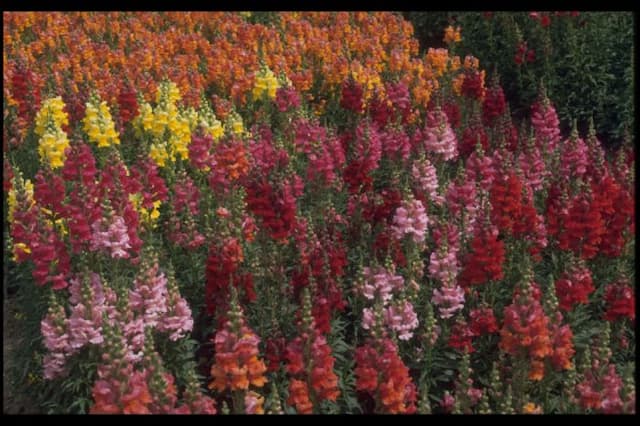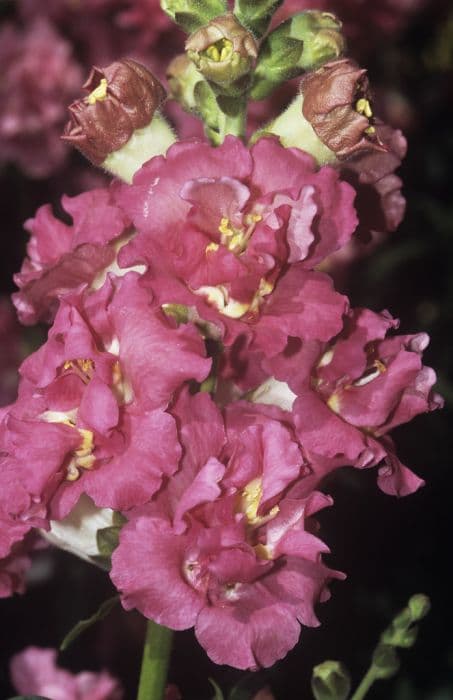Snapdragon Antirrhinum majus 'La Bella Red' (La Bella Series)

ABOUT
La Bella Red, belonging to the La Bella Series, is a strikingly vibrant plant known for its distinctive flowers which resemble open dragon mouths or little snapdragons. The blossoms showcase a deep red hue, providing a bold splash of color in any garden setting. The flowers are densely packed along the spike, creating a lush display of red that can attract various pollinators. Each flower has a bilateral symmetry with a tubular shape that opens at the mouth, revealing a paler throat often dotted with subtle color variations. The foliage of La Bella Red is a lush, deep green, forming a lush backdrop that makes the red flowers stand out even more dramatically. The leaves are typically lance-shaped, with a slightly textured surface that can be somewhat ruffled or smooth, depending on the environmental conditions. This snapdragon presents a bushy and full appearance with its foliage and flowers. Overall, La Bella Red is esteemed for its rich coloration and classic flower form, making it a cherished choice for gardeners who desire to inject a dose of warm, intense color into their landscapes. It is commonly grown for its ornamental value in flower beds, borders, and containers, where its vivid flowers can be showcased.
About this plant
 Names
NamesFamily
Plantaginaceae.
Synonyms
Snapdragon, Dragon Flower.
Common names
Antirrhinum majus.
 Toxicity
ToxicityTo humans
The common name for Antirrhinum majus is snapdragon. Snapdragons are not considered toxic to humans. Therefore, there are typically no symptoms of poisoning associated with ingesting snapdragons, and ingesting parts of this plant is unlikely to cause harm. However, it is generally advisable not to consume ornamental plants.
To pets
Snapdragons are not known to be toxic to pets. If a pet ingests parts of a snapdragon plant, it should not experience any symptoms of poisoning. Nonetheless, it is always good practice to keep an eye on pets after they have eaten unusual substances as individual reactions can vary, and to consult with a veterinarian if any concerning symptoms arise.
 Characteristics
CharacteristicsLife cycle
Annuals
Foliage type
Deciduous
Color of leaves
Green
Flower color
Red
Height
1-3 feet (0.3-0.9 meters)
Spread
1-2 feet (0.3-0.6 meters)
Plant type
Herb
Hardiness zones
9
Native area
Mediterranean
Benefits
 General Benefits
General Benefits- Aesthetic Appeal: Snapdragons like Antirrhinum majus 'La Bella Red' add vibrant color and visual interest to gardens and landscapes with their bright red blossoms.
- Pollinator Friendly: They attract beneficial insects such as bees and butterflies, which are essential for pollination and the health of the garden ecosystem.
- Versatility: These plants are suitable for various garden settings, including borders, flower beds, and containers, offering flexibility in garden design.
- Seasonal Interest: Snapdragons generally bloom from spring to fall, providing long-lasting floral displays throughout the growing seasons.
- Cut Flowers: Their tall, showy spikes make excellent cut flowers for bouquets and floral arrangements, extending their beauty indoors.
- Easy to Grow: Antirrhinum majus is known for being an easy-to-grow plant, which is ideal for novice gardeners or those looking for low-maintenance options.
- Cold Tolerance: Snapdragons can tolerate cooler temperatures, which makes them a good choice for early spring and late fall plantings in temperate climates.
 Medical Properties
Medical Properties- This plant is not used for medical purposes.
 Air-purifying Qualities
Air-purifying QualitiesThis plant is not specifically known for air purifying qualities.
 Other Uses
Other Uses- Artistic inspiration: Snapdragons, such as Antirrhinum majus 'La Bella Red', have unique flower shapes that often inspire artists and can be featured in paintings, drawings, and other forms of artistic expression.
- Floral photography: With their vibrant red flowers, snapdragons can serve as an excellent subject for macro and close-up photography, offering opportunities to capture the intricacies of their petals and structures.
- Educational tool: Gardeners and educators can use snapdragons to teach principles of botany and horticulture, including flower anatomy, pollination mechanisms, and plant growth habits.
- Magic tricks: Snapdragon flowers, which can be squeezed to make the ‘mouth’ open and close, have been used by magicians and entertainers in novelty acts and children’s magic tricks.
- Handcrafted cards and paper: Dried petals of the snapdragon can be used to make decorative elements on handcrafted cards or to be embedded into handmade paper for a unique texture and visual appeal.
- Dye production: Though not commonly used for this purpose, snapdragon petals could potentially be used to create natural dyes for coloring fabrics or crafting materials, yielding shades of red and pink.
- Culinary decoration: Although snapdragon flowers are not commonly eaten, they can be used as ornate and edible garnishes on cakes, salads, and gourmet dishes, assuming they have been grown without the use of harmful pesticides.
- Storytelling and symbolism: The striking appearance of snapdragon flowers can be incorporated into storytelling for children, or used as a symbol in literature and folklore, often representing grace, strength, or deception due to their ‘jaw-like’ flowers.
- Table centerpieces: Cut snapdragon stems are tall and eye-catching, making them suitable for creating dramatic floral centerpieces for events and home decoration.
- Ephemeral art: Fresh or dried snapdragon flowers can be arranged on surfaces to create temporary, nature-based art, which can then be captured in photographs before the elements naturally decay.
Interesting Facts
 Feng Shui
Feng ShuiThe Snapdragon is not used in Feng Shui practice.
 Zodiac Sign Compitability
Zodiac Sign CompitabilityThe Snapdragon is not used in astrology practice.
 Plant Symbolism
Plant Symbolism- Deception or Grace: Sometimes known as "dragon flowers" due to their dragon-shaped blooms, Snapdragons can symbolize both deception, as dragons are often seen as cunning, and grace, as the flower opens and closes elegantly with pressure.
- Strength: The sturdy stem of the Snapdragon is seen as a representation of strength and resilience in facing life's challenges.
- Protection: In folklore, Snapdragons were thought to offer protection from falsehoods and curses when planted in a garden or carried as a talisman.
- Power: Reflecting the mouth of a dragon, the bloom is often associated with power and assertiveness, as well as energetic vitality.
 Water
WaterThe Snapdragon 'La Bella Red' should be watered when the top inch of soil feels dry to the touch; this will typically be about once a week, but may vary depending on climate conditions. It's important to water deeply and thoroughly, using approximately one gallon of water for outdoor plants to encourage deep root growth. During hot summer months, you may need to water more frequently to maintain consistent soil moisture. Reduce watering in the winter when the plant’s growth slows down.
 Light
LightSnapdragons like 'La Bella Red' thrive in full sun, which means they require at least 6 to 8 hours of direct sunlight daily. The ideal spot for them is in a garden bed or a container where they can receive unfiltered sunlight for the majority of the day. If grown indoors, place them by a sunny window to ensure they get enough light.
 Temperature
TemperatureSnapdragons such as the 'La Bella Red' prefer cooler temperatures and can generally tolerate temperatures as low as 40°F without damage. They grow best in a temperature range between 60°F to 75°F, though they can survive up to about 85°F. Make sure to protect the plants from frost, and in extremely hot weather, they may need shade or extra water to stay cool.
 Pruning
PruningSnapdragons like 'La Bella Red' benefit from regular deadheading to encourage further blooming and maintain a neat appearance. Prune away spent flowers and any yellowing or dead leaves. Perform a more substantial cutback in late summer to promote a second round of blooms in the fall. The best time for major pruning is after the first wave of flowering has finished.
 Cleaning
CleaningAs needed
 Soil
SoilSnapdragons like well-draining soil with organic matter and prefer a neutral to slightly acidic pH of 6.2 to 7.0. A mix of two parts garden soil, one part peat or compost, and one part perlite or sand is ideal for 'La Bella Red' Snapdragons to flourish.
 Repotting
RepottingSnapdragons, like 'La Bella Red', don't typically require frequent repotting. They are often grown as annuals and will not need repotting. If grown as perennials, repot every 2 to 3 years in early spring to refresh the soil.
 Humidity & Misting
Humidity & MistingSnapdragons prefer moderate humidity levels; too high can promote fungal diseases. Average room humidity is generally suitable for 'La Bella Red' Snapdragons, but ensure good air circulation around the plants.
 Suitable locations
Suitable locationsIndoor
Place in bright, indirect light and keep soil slightly moist.
Outdoor
Plant in partial to full sun after the last frost in rich, well-draining soil.
Hardiness zone
7-10 USDA
 Life cycle
Life cycleAntirrhinum majus 'La Bella Red', commonly known as Snapdragon, begins its life as a seed planted in well-draining soil, usually in spring or autumn. The seed germinates within 1-2 weeks under the right conditions of warmth and moisture, and a seedling emerges with its first set of true leaves. As the Snapdragon grows, it enters the vegetative stage, developing a sturdy stem and a rosette of leaves at the base. Following vegetative growth, the plant enters the flowering stage where tall spikes adorned with velvety red flowers blossom, typically in late spring to summer. After pollination, often by bees or butterflies, the flowers will produce small fruit capsules containing seeds that, when mature, are released into the environment to complete the reproductive cycle. If left unpruned, Snapdragons can self-seed, which enables them to start the life cycle anew without human intervention.
 Propogation
PropogationPropogation time
Spring to early summer
Propogation: The Antirrhinum majus 'La Bella Red', commonly known as Snapdragon 'La Bella Red', is typically propagated using seeds. The optimal time for sowing Snapdragon 'La Bella Red' seeds is in late winter to early spring, aiming for seedlings to be ready to plant out after the danger of frost has passed. To propagate, seeds are scattered lightly on the surface of a well-draining seed starter mix and gently pressed into the soil, as they need light to germinate. Then, they are kept moist at a temperature of approximately 65-70 degrees Fahrenheit (18-21 degrees Celsius). Germination usually takes 10-21 days. Once seedlings have developed their first set of true leaves, they can be transplanted into individual pots and gradually hardened off before being planted out in the garden. This method is favored due to its simplicity and the abundance of seeds that one plant can produce.




![Snapdragon [Pretty in Pink]](/_next/image?url=https%3A%2F%2Fplants-admin.emdemapps.com%2Fimages%2Fplants%2F%2Fimages%2F604b5cb3b5385.png&w=640&q=75)




